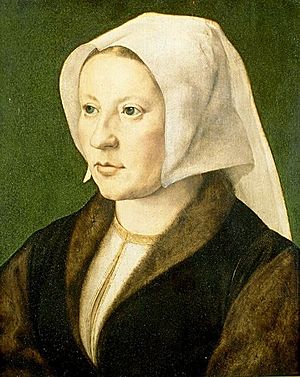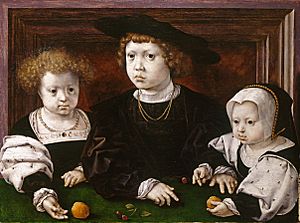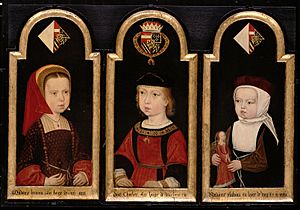Isabella of Austria facts for kids
Quick facts for kids Isabella of Austria |
|
|---|---|

Portrait by Mabuse
|
|
| Queen consort of Denmark and Norway | |
| Tenure | 12 August 1515 – 20 January 1523 |
| Coronation | 12 August 1515 Copenhagen Castle |
| Queen consort of Sweden | |
| Tenure | 1 November 1520 – 23 August 1521 |
| Born | 18 July 1501 Brussels, Habsburg Netherlands |
| Died | 19 January 1526 (aged 24) Ghent |
| Burial | St. Peter's Abbey, Ghent (1526–1883) St. Canute's Cathedral, Odense (since 1883) |
| Spouse | |
| Issue among others... |
John, Prince of Denmark Dorothea, Electress Palatine Christina, Duchess of Milan |
| House | Habsburg |
| Father | Philip I of Castile |
| Mother | Joanna of Castile |
| Religion | Roman Catholicism |
Isabella of Austria (born July 18, 1501 – died January 19, 1526) was a powerful queen. She was also known as Elizabeth. Isabella became the Queen of Denmark, Norway, and Sweden. She was married to King Christian II of Denmark. Isabella was the daughter of King Philip I of Castile and Queen Joanna of Castile. She was also the sister of Emperor Charles V. In 1520, she even ruled Denmark as a regent, which means she governed the country for the king.
Contents
Isabella's Early Life
Isabella was born in Brussels on July 18, 1501. She was the third child of Philip the Handsome and Joanna the Mad. Her father ruled the Burgundian Netherlands. Her mother was the heir to the Spanish kingdoms of Castile and Aragon.
Isabella's grandfather was Holy Roman Emperor Maximilian I. Her grandparents on her mother's side were the famous Catholic Monarchs, Ferdinand II of Aragon and Isabella I of Castile.
Isabella had two older siblings: Eleanor and Charles. She also had three younger siblings: Ferdinand, Mary, and Catherine. People at the time thought Isabella and her siblings were very special. Her brothers became powerful Holy Roman Emperors. Her sisters became queens in different countries like Portugal and France.
After her father died in 1506, Isabella's mother faced challenges with her health. Isabella, Charles, Eleanor, and Mary were then cared for by their aunt, Margaret of Austria. They lived at her court in Mechelen. Isabella, Eleanor, and Mary were educated together there.
Isabella was very important because of her family connections and her rights to inherit land. This made her a valuable person for royal marriages. The King of Denmark first wanted to marry Isabella's older sister, Eleanor. However, the Habsburg family thought Eleanor was too important for Denmark. This was because her children might have become rulers of many lands. So, Isabella was chosen to marry the Danish king instead.
On July 11, 1514, just before her 13th birthday, Isabella was married by proxy. This means someone stood in for the king during the ceremony. Her grandfather, Emperor Maximilian I, stood in for King Christian II of Denmark. Isabella stayed in the Netherlands after this. It is said she fell in love with Christian after seeing his painting. She asked to be taken to Denmark. A year later, in 1515, she traveled to Copenhagen. Her marriage was officially confirmed on August 12, 1515, when she was 14 years old.
Life as Queen
Isabella was crowned Queen of Denmark and Norway. She started using the name Elisabeth. At first, her relationship with her new family and King Christian was not easy. The King had a mistress named Dyveke Sigbritsdatter since 1507. He did not want to leave her for a teenager. Dyveke's mother, Sigbrit Willoms, also had a lot of influence at court. Isabella had less power than both of them.
This situation made Isabella's family, the Emperor, very angry. It caused some diplomatic problems between him and King Christian. However, things got better when Dyveke died in 1517. After that, Isabella's relationship with her husband improved a lot. She also became friends with Sigbrit Willoms. Both women became important advisors to the king.
In 1520, King Christian took the throne of Sweden. This made Isabella Queen of Sweden too. After taking Stockholm, he asked Swedish leaders to let Isabella rule Sweden if he died and his children were too young. Isabella was the last queen to be Queen of Sweden and Denmark at the same time during the Kalmar Union. However, she never actually visited Sweden. She was pregnant when her husband became King of Sweden, so she did not travel with him. Isabella served as the regent of Denmark while Christian was in Sweden. Her husband lost the Swedish throne the next year.
King Christian put many Swedish noblewomen in prison. These women were related to Swedish nobles who rebelled against him. They were held in the "Blue Tower" of Copenhagen Castle. Among them were Christina Gyllenstierna and Cecilia Månsdotter. Gustav I of Sweden used stories of their harsh treatment to turn people against Christian II. He claimed the king starved the women and children. He said they only survived because Queen Isabella showed them kindness.
In 1523, King Christian was removed from power by nobles who supported his uncle, Frederick I of Denmark. The new king wanted to have a good relationship with Isabella's family. He sent her a personal letter in her native German. He offered her money as a former queen and allowed her to stay in Denmark. King Christian had fled to the Low Countries. But Isabella replied in Latin, saying: "ubi rex meus, ibi regnum meum" ("where my king is, there is my kingdom"). This meant she would stay with her husband.
Life in Exile

Isabella left Denmark with her husband and children after he was removed from the throne in 1523. They traveled to the Netherlands. Isabella and Christian then traveled around Germany. They were trying to get help for Christian to become king again. Isabella talked to her relatives to get support. She also went with her husband on his journeys. They visited Saxony in 1523 and Berlin in 1523–1524.
In Berlin, Isabella became interested in the ideas of Martin Luther. She felt sympathy for Protestantism, a new Christian movement. However, she never officially changed her religion. When she visited Nürnberg in 1524, she took communion in the Protestant way. This made her family, the Habsburgs, very angry. Because of this, Christian decided she should hide her Protestant views in the future for political reasons.
In the spring of 1525, Isabella became very ill. Her health got worse after she traveled through a storm later that year. She was sick all summer. The former queen died at the castle of Zwijnaarde near Ghent. She was only twenty-four years old. She received both Protestant and Catholic communion before she died. However, her family, the Habsburgs, said she died as a strong Catholic. People still debate what her true religious beliefs were after 1524. On her deathbed, she asked her aunt, Margaret of Austria, to help her husband get his throne back.
Princess Isabella of Denmark, who lives today, is named after her. She is Isabella of Austria's fifteenth generation great-granddaughter.
Cultural Depictions
Literature
- Bruden fra Gent (English: The Bride from Ghent) is a historical novel from 2003. It was written by Dorrit Willumsen. The book is about King Christian II, Dyveke, her mother Sigbrit, and Isabella's marriage in 1515 when she was only 14 years old.
Issue
| Name | Birth | Death | Notes |
|---|---|---|---|
| John | 21 February 1518 | 1532 | died young. |
| Philip Ferdinand | 4 July 1519 | 1519 | twin, died as a baby. |
| Maximilian | 4 July 1519 | 1519 | twin, died as a baby. |
| Dorothea | 10 November 1520 | 31 May 1580 | married in 1535 to Frederick II, Elector Palatine. They had no children. |
| Christina | November 1521 | 10 December 1590 | married in 1533 to Francesco II Sforza. They had no children. She married a second time in 1541 to Francis I, Duke of Lorraine and had children. |
| Unnamed son | January 1523 | January 1523 | born stillborn. |
See also
 In Spanish: Isabel de Austria (1501-1526) para niños
In Spanish: Isabel de Austria (1501-1526) para niños



